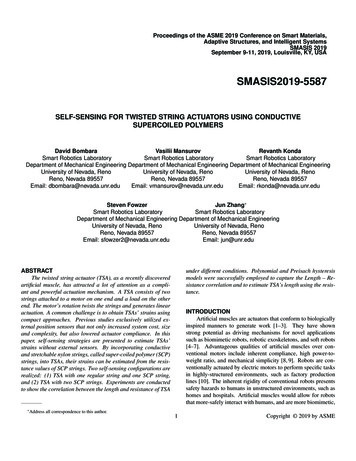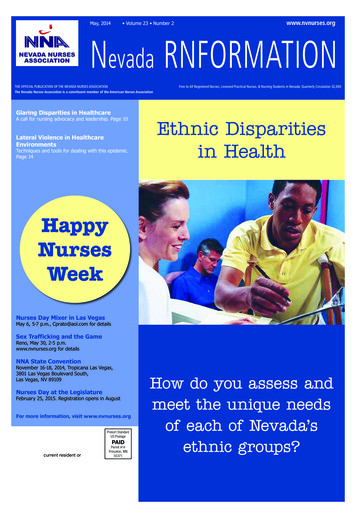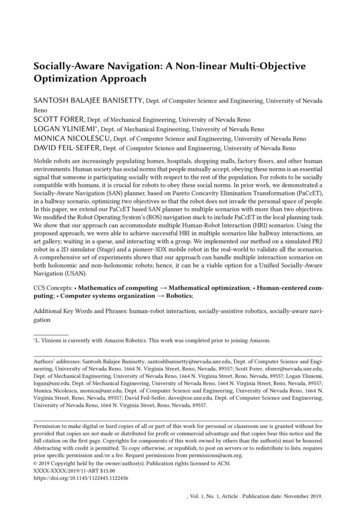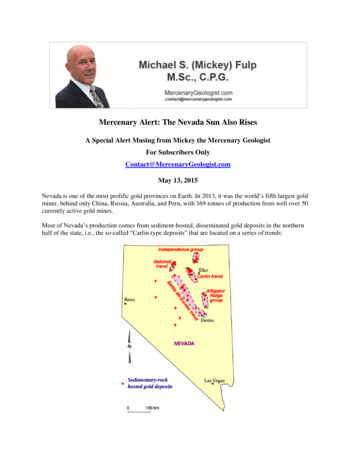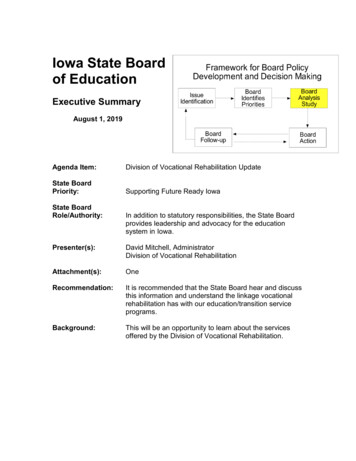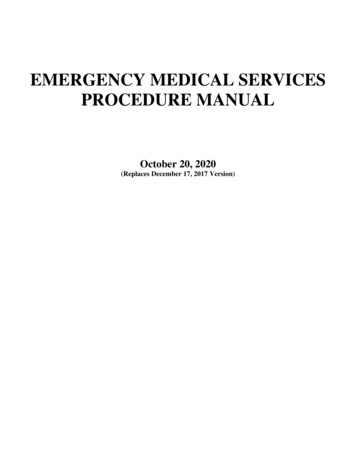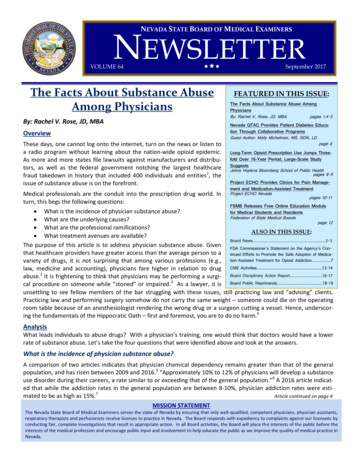
Transcription
NEVADA STATE BOARD OF MEDICAL EXAMINERSNEWSLETTERVOLUME 64 The Facts About Substance AbuseAmong PhysiciansBy: Rachel V. Rose, JD, MBAOverviewThese days, one cannot log onto the internet, turn on the news or listen toa radio program without learning about the nation-wide opioid epidemic.As more and more states file lawsuits against manufacturers and distributors, as well as the federal government notching the largest healthcarefraud takedown in history that included 400 individuals and entities1, theissue of substance abuse is on the forefront.Medical professionals are the conduit into the prescription drug world. Inturn, this begs the following questions:September 2017FEATURED IN THIS ISSUE:The Facts About Substance Abuse AmongPhysiciansBy: Rachel V. Rose, JD, MBApages 1,4-5Nevada QTAC Provides Patient Diabetes Education Through Collaborative ProgramsGuest Author: Molly Michelman, MS, RDN, LDpage 6Long-Term Opioid Prescription Use Jumps Threefold Over 16-Year Period, Large-Scale StudySuggestsJohns Hopkins Bloomberg School of Public Healthpages 8-9Project ECHO Provides Clinics for Pain Management and Medication-Assisted TreatmentProject ECHO Nevadapages 10-11FSMB Releases Free Online Education Module What is the incidence of physician substance abuse?for Medical Students and ResidentsFederation of State Medical Boards What are the underlying causes?page 12 What are the professional ramifications?ALSO IN THIS ISSUE: What treatment avenues are available?Board News. . .2-3The purpose of this article is to address physician substance abuse. Given FDA Commissioner’s Statement on the Agency’s Conthat healthcare providers have greater access than the average person to a tinued Efforts to Promote the Safe Adoption of Medicavariety of drugs, it is not surprising that among various professions (e.g., tion-Assisted Treatment for Opioid Addiction.7law, medicine and accounting), physicians fare higher in relation to drug CME Activities.13-14abuse.2 It is frightening to think that physicians may be performing a surgi- Board Disciplinary Action Report . . .16-17cal procedure on someone while “stoned” or impaired.3 As a lawyer, it is Board Public Reprimands .18-19ununsettling to see fellow members of the bar struggling with these issues, still practicing law and “advising” clients.Practicing law and performing surgery somehow do not carry the same weight – someone could die on the operatingroom table because of an anesthesiologist rendering the wrong drug or a surgeon cutting a vessel. Hence, underscoring the fundamentals of the Hippocratic Oath – first and foremost, you are to do no harm.4AnalysisWhat leads individuals to abuse drugs? With a physician’s training, one would think that doctors would have a lowerrate of substance abuse. Let’s take the four questions that were identified above and look at the answers.What is the incidence of physician substance abuse?A comparison of two articles indicates that physician chemical dependency remains greater than that of the generalpopulation, and has risen between 2009 and 2016.5 “Approximately 10% to 12% of physicians will develop a substanceuse disorder during their careers, a rate similar to or exceeding that of the general population.”6 A 2016 article indicated that while the addiction rates in the general population are between 8-10%, physician addiction rates were estimated to be as high as 15%.7Article continued on page 4MISSION STATEMENTThe Nevada State Board of Medical Examiners serves the state of Nevada by ensuring that only well-qualified, competent physicians, physician assistants,respiratory therapists and perfusionists receive licenses to practice in Nevada. The Board responds with expediency to complaints against our licensees byconducting fair, complete investigations that result in appropriate action. In all Board activities, the Board will place the interests of the public before theinterests of the medical profession and encourage public input and involvement to help educate the public as we improve the quality of medical practice inNevada.
BOARD NEWSMichael C. Edwards, MD, FACS Joins Nevada State Board of Medical ExaminersMichael C. Edwards, MD, FACS was appointed by Governor Sandoval to a position on the Nevada StateBoard of Medical Examiners effective July 1, 2017. The Board welcomes Dr. Edwards.Michael C. Edwards, MD, FACS, is a board-certified plastic and reconstructive surgeon in group practice in LasVegas; Anson, Edwards and Higgins Plastic Surgery Associates, with over 21 years of clinical experience.Dr. Edwards is a past president of the American Society for Aesthetic Plastic Surgery, and past president ofthe Clark County Medical Society. Dr. Edwards is a Fellow of the American College of Surgeons and a memberof many professional organizations, including the American Society for Aesthetic Plastic Surgery (past president and trustee), American Society of Plastic Surgery (serving on both the Ethics Committee and JudicialCouncil), American Association of Plastic Surgery, Clark County Medical Association (past president) and theNevada State Medical Association. Dr. Edwards lectures both nationally and internationally on all facets ofbreast surgery, specializing in complex breast revision.A veteran of the United States Air Force, where he was an active duty Air Force Plastic Surgeon and attainedthe rank of Lieutenant Colonel, Dr. Edwards graduated from the F. Edward Hebert School of Medicine (Uniformed Services University of the Health Sciences) in Bethesda, Maryland. He completed a residency in general surgery at David Grant Medical Center, Travis Air Force Base, in California, and a residency in plastic andreconstructive surgery at Wilford Hall Medical Center, Lackland Air Force Base, in Texas. Throughout his military career, Dr. Edwards served as Chief of Surgery, Chief of Plastic Surgery, and Chief of Staff. He also serveda tour in Kuwait supporting Operation Iraqi Freedom.Dr. Edwards is a proud member of the medical community of Nevada and has a strong commitment to thesafe and ethical delivery of medical care.BOARD MEMBERSRachakonda D. Prabhu, MD, PresidentWayne Hardwick, MD, Vice PresidentMr. M. Neil Duxbury, Secretary-TreasurerMs. Sandy PeltynVictor M. Muro, MDMs. April MastrolucaAury Nagy, MDMichael C. Edwards, MD, FACSWeldon Havins, MD, JD, LLMEdward O. Cousineau, JD, Executive DirectorNOTIFICATION OF ADDRESS CHANGE,PRACTICE CLOSURE AND LOCATION OFRECORDSPursuant to NRS 630.254, all licensees of the Boardare required to "maintain a permanent mailing address with the Board to which all communicationsfrom the Board to the licensee must be sent." Alicensee must notify the Board in writing of achange of permanent mailing address within 30days after the change. Failure to do so may resultin the imposition of a fine or initiation of disciplinary proceedings against the licensee.Please keep in mind the address you provide will beviewable by the public on the Board's website.Additionally, if you close your practice in Nevada,you are required to notify the Board in writingwithin 14 days after the closure, and for a period of5 years thereafter, keep the Board apprised of thelocation of the medical records of your patients.NEVADA STATE BOARD OF MEDICAL EXAMINERS Volume 64 September 2017 Page 2
BOARD NEWSWeldon Havins, MD, JD, LLM Joins Nevada State Board of Medical ExaminersWeldon (Don) Havins, MD, JD, LLM was appointed by Governor Sandoval to a position on the Nevada StateBoard of Medical Examiners effective August 31, 2017. The Board welcomes Dr. Havins.Dr. Havins attended the Coronado, California primary school system, then San Diego State University, wherehe received a BA with high honors. Graduating from Wake Forest University School of Medicine with an MDin 1970, he interned in surgery at the Washington Hospital Center in Washington, DC. Following two yearswith the U.S. Navy (one year as a medical officer on the USS Daniel Webster SSBN-626 nuclear submarine,one year at the Long Beach Regional Naval Medical Center), he completed an Ophthalmology residency atthe Jules Stein Eye Institute at UCLA in 1976, and later, a fellowship in Ophthalmic Plastic and ReconstructiveSurgery at the University of Texas, Houston, in 1981. He earned a Master’s degree in Management from theClaremont Graduate University while practicing Ophthalmology in Upland, California.From 1982 to 1995, Dr. Havins practiced Ophthalmology and Oculoplastic Surgery in Las Vegas, Nevada. Returning to San Diego in 1995, he attended law school at the University of San Diego, where he graduatedcum laude, was an editor of the law review, and was selected to Order of the Coif. Remaining at the University of San Diego School of Law for an additional year, he earned a Master of Laws degree, cum laude, inHealth Law.Returning to Las Vegas in 1999, Dr. Havins served as a law clerk for a district court judge while practicingmedicine part-time. From 2001 to 2008, he worked as the Executive Director and legal counsel for the ClarkCounty Medical Society. Following a stint as Executive Director of the Nevada State Board of OsteopathicMedicine, Dr. Havins received a full-time appointment to the faculty of Touro University College of Osteopathic Medicine, where he currently serves as an Associate Dean, Professor and Director Medical Jurisprudence, and Professor of Ophthalmology, while practicing General Ophthalmology part-time.Dr. Havins is a member of the Nevada Bar and is in-house counsel for Touro University Nevada. He is certified by the American Board of Ophthalmology and the American Board of Legal Medicine. He serves as amember of the Board of Governors of the American College of Legal Medicine and the American Board ofLegal Medicine. He is currently a Board Member of the Nevada State Board of Medical Examiners, and aBoard Member of the Governor’s Office of Economic Development.Dr. Havins is a fellow of the American College of Surgeons, the American Society of Ophthalmic Plastic andReconstructive Surgeons, and the American College of Legal Medicine. He is immediate past president of theNevada State Medical Association. He has numerous publications in medical journals and law reviews.Dr. Havins enjoys aviation and has earned Airline Transport Pilot ratings in both single and multi-engine aircraft. He has earned ratings as a certified flight instructor in single and multi-engine aircraft, and as an instrument flight instructor.Dr. Havins and his wife Kelly enjoy time with son Bradley, a U.S. Army Major in the Army Medical Corps(Family Medicine), daughter Laura, who is an R.N. working in a surgical intensive care unit while completingher Masters Degree as a Nurse Practitioner (UNLV), and daughter Anna, who teaches English in Kochi, Japan.NEVADA STATE BOARD OF MEDICAL EXAMINERS Volume 64 September 2017 Page 3
The Facts About Substance Abuse Among PhysiciansContinued from front page“Physicians are invested with awesome responsibility and trust.”8 A self-reported survey by 5,426 physicians from twelvedifferent medical specialties indicated that the use of a variety of substances, ranging from alcohol to marijuana to cocaine to opioids to benzodiazepines, revealed that pediatricians and surgeons had the lowest incidence of abuse. On theother end of the spectrum, anesthesiologists abused major opioids at a higher rate, while psychiatrists and emergencyphysicians topped the charts for overall substance abuse and addiction.9Indeed, of all of the professions, society entrusts doctors to touch us, to render anesthesia to us and to rid us of a varietyof wide-ranging ailments. Given that physicians are intelligent and driven individuals, the question begged is - what leadsto substance abuse?What are the underlying causes?According to a 2013 Journal of Addiction Medicine study, 69% of doctors abused prescription medicine “to relieve stressand physical or emotional pain.”10 As Dr. Marc Myer would state, “tomorrow – tomorrow, I will stop” as he continued tosteal his patient’s opioids to fuel his own addiction.11 Dr. Myer, like most physicians, was not seeking a “recreational thrill”from the drugs. Rather, he used them as a way to cope with depression.Dr. Myer’s experience mirrors that of research published in the Journal of Addiction Medicine. The study, which includedinterviews of 55 physicians who were being monitored by various state physician health programs, revealed that 69% ofphysicians abused prescription drugs. And, as stated above, the impetus was to alleviate stress and pain (e.g., emotionaland physical).12In July 2010, JAMA published a survey that revealed the following: 17% of nearly 1900 responding physicians reported having directknowledge of an impaired or incompetent colleague in their practice or on the medical staff over the past three years;One-third did not report the individual; andThe reasons given for not reporting included: believed someoneelse was taking care of the problem (19%), didn't think reporting theproblem would make a difference (15%), feared retribution (12%),felt it wasn't their responsibility to report (10%), or worried that thephysician would be excessively punished (9%).13Hence, the takeaway is that not reporting is far from a “professional courtesy.” And, failing to report could have significant professional ramifications.What are the professional ramifications?The professional ramifications associated with addiction include: being arrested and charged with either misdemeanorsand/or felonies, loss or suspension of a medical license, removal from a practice and/or medical staff and earnings. Personally, a marriage may end or family and friends may abandon the physician.14As Dr. Peter Grinspoon shared, “I've been in recovery since 2007. After I regained my medical license, I was asked to jointhe Physician Health Service as an associate director, helping other addicted doctors. As it turns out, physicians, once theyget help, often excel at rehab. According to health service studies, we succeed at rates of 70% to 80%, which for addictionis astronomically high.”15 Dr. Grinspoon’s experience underscores that once a physician enters treatment, the ability toovercome the addiction and reenter the medical profession successfully is exceptional. Therefore, it is in both the physicians’ and the patients’ best interests for physicians to seek treatment and resume medical practice with continued andappropriate monitoring.continued on page 5NEVADA STATE BOARD OF MEDICAL EXAMINERS Volume 64 September 2017 Page 4
The Facts About Substance Abuse Among Physicianscontinued from page 4What treatment avenues are available?Impairment has been defined as, “the inability or impending inability to practice according to accepted standards as a result of substance use, abuse, or dependency (addiction).”16 Both prevention and detection begin at the local level throughmonitoring and ensuring acceptable physician performance.17“Society has begun to shift from viewing addiction as a moral failing that deserves punishment to understanding it as adisease that can be successfully treated. That's no less true for physicians than for everyone else.” 18 The Federation ofState Medical Boards and the Federation of State Physician Health Programs are great places for physicians, state medicalboards and hospitals/group practices to begin their research. Help is available but physicians must remember that theirown issues must be balanced against those of protecting society. As a matter of public policy, physicians have the utmostfiduciary duty. Therefore, don’t be surprised if an aggressive lawyer is fueled with passion to go after a physician for harming a patient or placing patients in harm’s way.ConclusionThe consensus of medical boards and various publications indicates that a “blind-eye” should not be turned in relation toexisting or suspected physician addiction. Rather, seeking help through physician health programs, which are run in accordance with the Federation of State Physician Health Programs and the Federation of State Medical Boards’ guidelines,is a prudent first step. With the increasing complexities and demands of the medical profession, it is possible that the substance abuse rate may again increase. Therefore, physicians, their colleagues and their families need to be vigilant forsigns of addiction and substance abuse; and, also remember, prinum non nocere – “first, do no harm.”1B. Jones Sanborn, HHS announces 'largest fraud takedown in history', charging 400 defendants in schemes involving 1.3 billion in false billings (July 13, -400-defendants-schemes-involving-132T. McVeigh, Alarm at growing addiction problems among professionals (Nov. 12, 2011); ctors-lawyers-alcohol-addiction.3American Academy of Orthopaedic Surgeons, The Impaired Physician; d 31367.4Council on Ethical and Judicial Affairs: Code of Medical Ethics, Opinions8.15, 9.0305, 9.031. Chicago, IL, American Medical Association, ed(2014-2015); ge.5K. Berge, M. Seppala, and A. Schipper, Chemical Dependency and the Physician, Mayo Clin Proc., 2009 Jul; 84(7): PMC2704134/.6Hughes PH, Brandenburg N, Baldwin DC, Jr, et al. Prevalence of substance use among US physicians [published correction appearsin JAMA. 1992;268(18):2518] JAMA 1992;267(17):2333-2339.7P. Grinspoon, Up to 15% of doctors are drug addicts. I was one of them. (Jun. 5, 2016); on-addicted-doctors-20160605snap-story.html. Peter Grinspoon is a primary care physician and an instructor at Harvard Medical School. He is the author of Free Refills: A Doctor Confronts His Addiction.8Ibid.9P.H. Hughes, et al., Physician substance use by medical specialty. J Addict Dis. 1999; 18(2): 23-27; ra n. 6.11S. Reese, Drug Abuse Among Doctors: Easy, Tempting, and Not Uncommon (Jan. 29, 2014), 13S. Reese, Drug Abuse Among Doctors: Easy, Tempting and Not Uncommon (Jan. 29, 2014); http://www.medscape.com/viewarticle/819223 4.14L. Leape and J. Fromson, Problem Doctors: Is There a System-Level Solution?, Ann Intern Med. 2006; 144: 107-115.15Supra n. 6.16M. Baldisseri, Impaired healthcare professional. Critical Care Med. 2007 Feb; 35 (2 Suppl): S106-16; ra n. 13.18Supra n. 6.Rachel V. Rose, JD, MBA is a Principal with Rachel V. Rose – Attorney at Law, P.L.L.C. (Houston, TX).Ms. Rose has a unique background, having worked in many different facets of health care, securities and international law and business throughout her career. She ispublished and presents on a variety of topics including: Dodd-Frank, the False Claims Act, the Foreign Corrupt Practices Act, physician reimbursement, women's health,ICD-10, access to care, anti-kickback and Stark laws, international comparative laws, cyber security and the HIPAA/HITECH Act. Her practice focuses on a variety ofcyber security, health care and securities law issues related to industry compliance, transactional work and Dodd-Frank/False Claims Act whistleblower claims, whichremain under seal.Ms. Rose holds an MBA with minors in health care and entrepreneurship from Vanderbilt University, and a law degree from Stetson University College of Law, whereshe graduated with various honors. She is licensed to practice in Texas. She has co-authored various books and book chapters, including the American Bar Association'sWhat Are International HIPAA Considerations? Currently, she is on the Executive Committee of the Federal Bar Association’s Qui Tam Section and a member of theGovernment Relations Committee. Ms. Rose is an Affiliated Member with the Baylor College of Medicine’s Center for Medical Ethics and Health Policy, where sheteaches bioethics. She also serves on the Southwest Regional Board for UNICEF. She can be reached at rvrose@rvrose.com.Disclaimer: The opinions expressed in the article are those of the author, and do not necessarily reflect the opinions of the Board members or staff ofthe Nevada State Board of Medical Examiners.NEVADA STATE BOARD OF MEDICAL EXAMINERS Volume 64 September 2017 Page 5
Nevada QTAC Provides Patient Diabetes EducationThrough Collaborative ProgramsThrough Collaborative EffortsGuest Author: Molly Michelman, MS, RDN, LDA highly proactive approach to patient care is being implemented by healthcare practitioners nationwide, specifically inthe area of diabetes. In Nevada, according to the BehavioralRisk Factor Surveillance System (BRFSS) data, it is estimatedthat 215,082, or 9.7%, of adults were diagnosed with diabetes in 2015.1 Prediabetes, which is treatable, has its ownset of stunning statistics. One in three adults nationally - that’s 84 million - has prediabetes; and for those age 65 orolder, 1 in 2 have the condition.2 More alarming is that 9 out of 10 do not know that they have prediabetes.3 For theyear 2012, Nevada’s total estimated medical cost for diabetes was 2,466 million, with prediabetes representing 194 million.4 BRFSS 2015 data estimates that 38% of Nevada adults were overweight while 26.7% of Nevada adultswere obese. The prevalence of adults in Nevada with a diabetes diagnosis who are obese is close to double that ofthose who do not have diabetes. Obesity, according to the BRFSS, is defined as having a body mass index (BMI) 30.5A similar trend exists for prediabetes.Numbers such as these are overwhelming, and the potential impact on healthcare teams is considerable. In an effortto help reduce the burden, and prevent patient progression to type 2 diabetes, the American Medical Associationand the CDC developed a toolkit (https://preventdiabetesstat.org/toolkit.html) to be used for screening and testing,and to help them to refer at-risk patients to face-to-face or online diabetes prevention programs.Practitioners may not know where to refer patients in need of prediabetes or diabetes education. The Nevada Quality and Technical Assistance Center (Nevada QTAC) is a neutral organization, serving as the leader in execution ofprogram implementation, expansion, and sustainability of diabetes education programs throughout the state of Nevada. Nevada QTAC seeks to decrease the prevalence of diabetes by collaborating with key members of the community, healthcare providers, insurance providers and health plans to increase awareness of evidence-based programs.The goal is to improve health outcomes and quality of life of those suffering from diabetes and other chronic illnesses. Evidence-based programs support Nevada QTAC’s foundation, including the National Diabetes Prevention Program (DPP) and Stanford Self-Management Programs such as the Chronic Disease Self-Management Program(CDSMP), Diabetes Self-Management Program (DSMP), and Manejo Personal de la Diabetes (PMPD).Further information about various sessions or workshops and locations/class times is available through the followingwebsites: Nevada QTAC - http://nvhealthyliving.org/; National Diabetes Prevention Program - www.cdc.gov/diabetes/prevention; Nevada Diabetes Education for Resources and Information Within the state tes-education/.1Nevada Division of Public and Behavioral Health, Behavioral Risk Factor Surveillance System Survey (BRFSS) Data. Carson City, Nevada: Nevada Department of Health and Human Services,Division of Public and Behavioral Health, Office of Public Health Informatics and Epidemiology, 2015.2Centers for Disease Control and Prevention. National Diabetes Statistics Report: Estimates of Diabetes and Its Burden in the United States, 2014. Atlanta, GA: U.S. Department of Health andHuman Services, Centers for Disease Control and Prevention, 2014.3Centers for Disease Control and Prevention (CDC). Awareness of Prediabetes--United States, 2005-2010. MMWR Morb Mortal Wkly Rep. 2013 Mar 22;62(11):209-12.4Wenya Yang; Timothy M.; Pragna Halder; Paul Gallo; Stacey L. Kowal; and Paul F. Hogan; Economic Costs of Diabetes in the U.S. in 2012, Diabetes Care April 2013 vol. 36 no. 4 1033-1046.5Centers for Disease Control and Prevention, National Center for Chronic Disease Prevention and Health Promotion, Division of Population Health. BRFSS Prevalence & Trends Data [online].2015. https://www.cdc.gov/brfss/brfssprevalence/. Accessed 8/25/17.Molly Michelman, MS, RDN, LD is the owner of The Food Connection, a private dietetics practice in Las Vegas. Molly was the didactic program director and on faculty forUniversity of Nevada, Las Vegas’ Nutrition Sciences Program for 17 years. Molly has been a registered dietitian since 1999, and has worked in that time as a consultantand educator for Southwest Medical Associates, MGM Mirage, Paiute Tribe, Southern Nevada Health District, Create a Change Now, Dignity Health, Clark County SchoolDistrict, Families for Effective Autism Treatment, and University of Nevada Reno Cooperative Extension and School of Medicine. She also teaches weekly diabetes education classes in southern Nevada.Disclaimer: The opinions expressed in the article are those of the author, and do not necessarily reflect the opinions of the Board members or staff of the Nevada StateBoard of Medical Examiners.NEVADA STATE BOARD OF MEDICAL EXAMINERS Volume 64 September 2017 Page 6
Statement from FDA Commissioner Scott Gottlieb, MD onthe Agency’s Continued Efforts to Promote the Safe Adoption of Medication-Assisted Treatment for Opioid AddictionStatementMedication-assisted treatment (MAT) – the use of medicationcombined with counseling and behavioral therapies – is one ofthe major pillars of the federal response to the opioid epidemic in this country. This type of treatment is an important toolthat has the potential to help millions of Americans with anopioid use disorder regain control over their lives. In fact, patients receiving MAT cut their risk of death from all causes inhalf, according to the Substance Abuse and Mental Health Services Administration. Addressing the epidemic of opioid addiction is my highest public health priority. One element of that effort is promoting more widespread, safe adoption ofMAT as a way to help more people overcome addiction.However, health care providers and patients face significant challenges when determining how best to treat opioid usedisorder, especially when the MAT drugs contain methadone or buprenorphine – which are also opioids. For example,many patients with opioid use disorder might abuse other substances or have a co-existing chronic condition, such as amental health disorder. This may require separate treatment using medications that, when combined with the MAT drugsmethadone or buprenorphine, may pose serious risks. Today, the FDA issued a Drug Safety Communication alerting healthcare providers and patients of the increased risk of serious side effects when combining these particular MAT drugs withbenzodiazepines – often prescribed to treat anxiety, insomnia, or other conditions – and how to address these risks whilecontinuing to maintain patients on MAT. In addition, the FDA also recently strengthened labeling for the MAT drug buprenorphine to emphasize that patients may require treatment indefinitely and should continue treatment for as long asthey benefit and as long as the use of MAT contributes to their intended treatment goals.As noted in the Drug Safety Communication, the co-administration of the MAT drugs methadone or buprenorphine withbenzodiazepines or other central nervous system (CNS) depressants can pose serious risks, including difficulty breathing,coma, and death. The FDA’s new alert follows the agency’s warning last year of the risks of using opioid analgesics (totreat pain) or prescription opioid cough products and benzodiazepines at the same time. At that time, more considerationwas needed regarding the combined use of these MAT drugs and benzodiazepines or other CNS depressants due to theunique medical needs and benefit-risk considerations for this specific patient population. As a result of that consideration,the FDA’s new advisory that we’re issuing today asks health care providers and patients to be aware of these risks. But atthe same time, the agency is also reinforcing that MAT should not necessarily be denied to patients taking these othermedications. The dangers associated with failing to treat an opioid use disorder can outweigh the risks of co-prescribingMAT and benzodiazepines. Instead, careful management of the patient and coordination of care is recommended.To underscore the importance of appropriately utilizing MAT products, the FDA is requiring changes to MAT drug labels tohelp decrease the risks of combining these drugs, while taking steps to address situations where the MAT drugs methadone or buprenorphine might be co-administered with benzodiazepines. The new labeling recommends that health careproviders develop a treatment plan that closely monitors any concomitant use of these drugs, and carefully taper the useof benzodiazepines, while considering other treatment options to address mental health conditions that the benzodiazepines might have been initially prescribed to address.Reducing the number of Americans who are addicted to opioids and cutting the rate of new addiction is one of the FDA’shighest priorities. We must do everything possible to address the staggering human toll caused by opioid use disorders,and ensuring patients receive proper treatment for both addiction and coexisting mental health conditions is a criticalstep
NEVADA STATE BOARD OF MEDICAL EXAMINERS Volume 64 September 2017 Page 4 Continued from front page “Physicians are invested with awesome responsibility and trust.”8 A self-reported survey by 5,426 physicians from twelve different medical specialties indicated that the use of a variet
